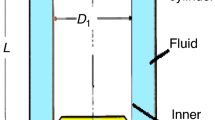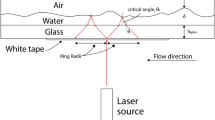Abstract
We analyze quantitatively the oxidative degradation of a sample in a parallel-disk rheometer, as oxygen diffuses inward, radially, from the free boundary. We examine rheometer error mitigation by means of nitrogen blanketing, and also, of parallel-disk partitioning. We arrive at exact analytical expressions for the oxygen concentration and, thus, for the degradation rate. We then integrate this rate over time to get the amount of oxygen reacted as a function of radial position and time in the degrading sample. To illustrate the usefulness of our analytical expressions, we provide two worked examples investigating the effect of nitrogen blanketing and parallel-disk partitioning. We find that, though nitrogen blanketing always produces less degradation, its benefits are limited for short times. Additionally, parallel-disk partitioning provides a simpler solution and allows samples to be run for longer times without degradation compromising measurement, even in samples initially saturated with oxygen. We also consider the effect of antioxidants. We also consider an important special case, without chemical reaction, where the sample dries by evaporation from its free surface. We close by comparing the roles played by polymer degradation in parallel-disk flow versus cone-plate flow.















Similar content being viewed by others
References
Auriemma M, Piscitelli A, Pasquino R, Cerruti P, Malinconico M, Grizzuti N (2015) Blending poly(3-hydroxybutyrate) with tannic acid: influence of a polyphenolic natural additive on the rheological and thermal behavior. Eur Polym J 63:123–131
Billingham NC (2007) Degradation. In: Encyclopedia of polymer science and technology. Concise, 3rd edn. Wiley, pp 315–321
Bird RB, Armstrong RC, Hassager O (1987) Dynamics of polymeric liquids, Vol. 1, 2nd edn. Wiley, New York
Bird RB, Stewart WE, Lightfoot EN (2007) Transport phenomena. Revised, 2nd edn. Wiley, New York
Crank J (1975) The mathematics of diffusion, 2nd edn. Clarendon Press, Oxford
Damköhler G (1936) Einflüsse der Strömung, diffusion und des Wärmeüberganges auf die Leistung von reaktionsöfen.: I. allgemeine Gesichtspunkte für die übertragung eines chemischen Prozesses aus dem kleinen ins grosse. Z Elektrochem Angew Phys Chem 42:846–862
Dealy JM, Wissbrun KF (1990) Melt rheology and its role in plastics processing: theory and applications. Van Nostrand Reinhold, New York
Fowler RH (1914) Some results on the form near infinity of real continuous solutions of a certain type of second order differential equation. Proc Lond Math Soc 13:341–371
Fowler RH (1931) Further studies of Emden's and similar differential equations. Q J Math 2:259–288
Giacomin AJ, Gilbert PH, Merger D, Wilhelm M (2015) Large-amplitude oscillatory shear: comparing parallel-disk with cone-plate flow. Rheol Acta 54:263–285
Giacomin AJ, Gilbert PH (2018) Degradation in cone-plate rheometry. Rev Sci Instrum 89:124101
Hellström LHO, Samaha MA, Wang KM, Smits AJ, Hultmark M (2015) Errors in parallel-plate and cone-plate rheometer measurements due to sample underfill. Meas Sci Technol 26:015301
Nijenhuis K (2007) Part c specific experimental environments and techniques. In: Tropea C, Yarin AL, Foss JF (eds) Springer handbook of experimental fluid mechanics. Springer, Berlin
Schweizer T (2002) Measurement of the first and second normal stress differences in a polystyrene melt with a cone and partitioned plate tool. Rheol Acta 41:337–344
Schweizer T (2003) Comparing cone-partitioned plate and cone-standard plate shear rheometry of a polystyrene melt. J Rheol 47:1071–1085
Schweizer T (2004) A quick guide to better viscosity measurements of highly viscous fluids. Appl Rheol 14:197–201
Schweizer T, van Meerveld J, Öttinger HC (2004) Nonlinear shear rheology of polystyrene melt with narrow molecular weight distribution-experiment and theory. J Rheol 48:1345–1363
Snijkers F, Vlassopoulos D (2011) Cone-partitioned-plate geometry for the ARES rheometer with temperature control. J Rheol 55:1167–1186
Uhniat M, Kudła S (2001) Stabilisation of LDPE cross-linked in the presence of peroxides: I Kinetic study of the oxidation. Polym Degrad Stab 71:69–74
Acknowledgments
Principal’s Development Fund Visiting Scholar, R. Pasquino, thanks the Office of the Principal and the Chemical Engineering Department for supporting her stay at Queen’s University. This research was undertaken, in part, thanks to the support from the Canada Research Chairs program of the Government of Canada for the Natural Sciences and Engineering Research Council of Canada (NSERC) Tier 1 Canada Research Chair in Rheology. This research was also undertaken, in part, thanks to the support from the Discovery Grant program of the Natural Sciences and Engineering Research Council of Canada (NSERC) (A.J. Giacomin) and the Vanier Canada Graduate Scholarship (P.H. Gilbert).
Funding
A.J. Giacomin is indebted to the Faculty of Applied Science and Engineering of Queen’s University at Kingston, for its support through a Research Initiation Grant (RIG). P.H. Gilbert is grateful for an International Tuition Award from the School of Graduate Studies of Queen’s University at Kingston.
Author information
Authors and Affiliations
Corresponding author
Additional information
Publisher’s note
Springer Nature remains neutral with regard to jurisdictional claims in published maps and institutional affiliations.
Appendices
Appendices
Solving Eq. (16)
Equation (16) has the form of the Emden-Fowler equation (Fowler 1914; Fowler 1931), which has general solution:
which is subject to Eqs. (6) and (7). In Eq. (56), J0 is zeroth order Bessel function of the first kind, and Y0, of the second kind. Differentiating Eq. (56), we find:
Subjecting Eq. (57) to Eq. (7) gives:
and thus:
so that:
which, subject to Eq. (6), gives:
or:
so that:
which is Eq. (17) above.
Solving Eq. (29)
Supposing that:
so that from Eq. (30):
and thus, we have the rim condition:
and from Eq. (32):
Substituting Eq. (65) into Eq. (29):
which has general solution:
and:
in which:
Equation (74) has the form of the Emden-Fowler equation (Fowler 1914; Fowler 1931), so that:
Subjecting Eq. (76) to the rim condition, Eq. (67) yields:
Differentiating Eq. (76) yields:
and subjecting this to Eq. (69):
and thus:
and our rim condition, Eq. (67), gives:
so that:
where j0, n is the nth zero of J0, so that:
Substituting Eq. (82) into Eq. (80) yields:
Substituting Eqs. (73), (83), and (84) into Eq. (65) yields:
Applying Eq. (31) to Eq. (85):
since J0(−j0, nα) = J0(j0, nα). For such infinitely summed series, we multiply through by αJ0(j0, mα), and then integrate over the entire range of α to get:
Mindful of the following orthogonal properties (Eqs. (5.16) and (5.17) of Crank 1975):
Equation (87) then becomes:
Reversing m back to n gives:
so that:
Substituting this into Eq. (85) gives:
which is Eq. (33) above.
Solving χ t(α, τ) in Eq. (37)
To get the transient part, we revise the atmospheric boundary condition, Eq. (21), to:
so that Eq. (30) becomes:
and from Eq. (17):
we rearrange Eq. (94) to:
The initial condition must also be revised to:
so that:
Because the initial condition is the only difference from the nitrogen blanket, we can start by following Eq. (85):
which we subject to Eq. (98) to get:
Following Eq. (90):
which is only nonzero when m = n:
Solving for Bn, we get:
Substituting this into Eq. (99) gives us the transient part:
which is Eq. (38) above.
Rights and permissions
About this article
Cite this article
Giacomin, A.J., Pasquino, R., Saengow, C. et al. Degradation in parallel-disk rheometry. Rheol Acta 58, 291–305 (2019). https://doi.org/10.1007/s00397-019-01128-0
Received:
Revised:
Accepted:
Published:
Issue Date:
DOI: https://doi.org/10.1007/s00397-019-01128-0




